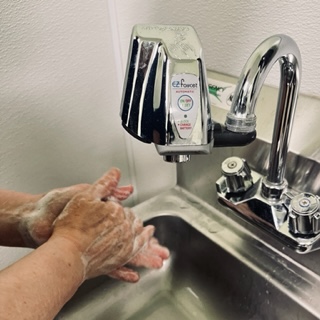Drips to Sips: Changing How You Wash Your Hands Can Save Drinking Water and Save You Money

Handwashing is an essential practice in any food manufacturing facility to ensure the hygiene and safety of the food produced. In our bakery, we have taken measures to reduce how much water we are using and while maintaining hand sanitation at the same time. It not only feels good to save money on our water bill, but we really enjoy how we frame and think about the amount of water that we are saving.
Let's do some math and show you what we're talking about! We've determined that our employees will wash their hands at least 10 times a day to minimize the risk of contamination. This includes before entering the kitchen, as we leave the kitchen for break, after using the restroom, returning from break and entering the kitchen, as we leave the kitchen for lunch, after using the restroom, returning from lunch and entering the kitchen, as we leave the kitchen for the day, and every time we change jobs or change gloves.
Next, we need to determine how much water is used during one handwashing. A standard flow faucet can use 2.2 gallons of water per minute, as set by Federal Regulations. The CDC (Centers for Disease Control) states that effective handwashing takes about 30 seconds which means we would be using about 1.1 gallons of water each time we wash our hands. However, we've installed a hands-free faucet on each of our kitchen and bathroom handwashing sinks. These faucets only run the water while wetting and rinsing our hands, not during the recommended 15-20 seconds of scrubbing.
Conservatively, we estimate that by not running the water during scrubbing, we are saving 0.5 gallons per handwash. 10 washes per day at 0.5 gallons saved = 5 gallons saved per day. For 5 days per week, that's 25 gallons per week. With 50 work weeks per year it means that we're saving 1250 gallons per year, per person! Divide that by all 365 days in the year, we find that we save 3.4 gallons a day per employee.
Now to our unique way of putting this into perspective: saving water that could otherwise be used as drinking water. An average person needs to drink 8 cups or half a gallon of water per day. Therefore, by conserving 3.4 gallons of water per day, over the course of a year we save enough water to account for the drinking water needed by 6.8 people for that entire year! We think that's amazing, inspiring, and so important to share!
The particular "EZ Faucet" that we use can be used on just about any sink setup so this isn't just a shout out to other businesses. You can do it at your own home as well! Think of it more as an adapter than permanently replacing your old faucet with a new one. You won't even need any fancy plumber's tools. Maybe a wrench if your old aerator is on really tight, but that's it.
Speaking of aerators, we do understand that a hands-free faucet may not be right or feasible for everyone. You can at least make sure that your faucet has a low-flow aerator which is an inexpensive part to pick up if you need it. According to the Environmental Protection Agency (EPA), adding an aerator to your faucet can help save water, up to 30%. These handy devices add air to the water stream, causing you to use less water without minimizing the "feel" of the flow. Even this smaller reduction compared to an automatic faucet, yields the kinds of water saving results that means there's substantially more water for all of us to drink.
While hand washing is an essential practice in any food manufacturing facility, it doesn't have to come at the cost of water waste. Installing hands-free faucets or aerators can help conserve water and promote sustainability while still maintaining effective hand washing practices. And remember... those extra drips could be turned into sips!
